
Most lawyers know SEO is important but struggle to understand how it actually works. They’ve been burned by agencies that overpromise, confused by jargon-heavy articles, or frustrated by tactics that generate traffic without delivering clients.
You don’t need to master SEO.
You need to know what matters and what to ignore. When you understand how Google, Bing, and AI search tools like ChatGPT evaluate law firm websites, you can make better decisions, delegate with confidence, and avoid costly missteps.
What follows is a clear, practical roadmap for building long-term visibility that drives meaningful results.
Explore each topic in depth. These are separate pages diving deep into each aspect of SEO for law firms.
Law firm SEO helps your website show up when potential clients search for legal help in your area. It earns trust by providing accurate, expert-driven answers that meet Google’s high standards for legal content.
That also includes Bing, and increasingly, AI search tools like ChatGPT and Perplexity.
Unlike traditional ads, SEO helps you earn visibility by creating content that answers real questions, demonstrates expertise, and satisfies search intent.
But legal SEO isn’t generic SEO. Because legal advice impacts people’s lives, Google holds your content to a higher standard. To show up consistently, your site needs to be accurate, trustworthy, and aligned with what search engines call “Your Money or Your Life” content quality standards.
Google’s traditional search results still matter. But they’re no longer the only way potential clients discover your firm.
AI-driven tools like ChatGPT, Bing Copilot, and Google’s AI Overviews now provide direct answers, often without linking out to a website. To stay visible, your content must be reference-worthy.
For law firms, that means prioritizing clarity, authority, and structure. These platforms favor sources they trust, especially content that is well-organized, clearly written, and semantically rich.
At the same time, Google’s local pack continues to drive high-converting traffic from mobile and “near me” searches.
Legal content isn’t like other content. Because it can impact someone’s finances, freedom, or future, Google classifies it as “Your Money or Your Life” (YMYL) content.
That means it’s held to a higher standard, one that demands accuracy, clarity, and genuine authority.
If your content is vague, outdated, or written to game search engines rather than help people, it won’t perform. Google, and increasingly, AI-driven tools, are designed to reward websites that demonstrate real expertise and deliver trustworthy, useful information.
That’s where E-E-A-T comes in. Google evaluates your content based on four key trust signals:
Clients and search engines need to know they can rely on you. That trust must be evident across every page on your site, not buried in a footer or resume.
Key takeaway: Your content must show that you’re qualified, experienced, and trustworthy everywhere it appears.
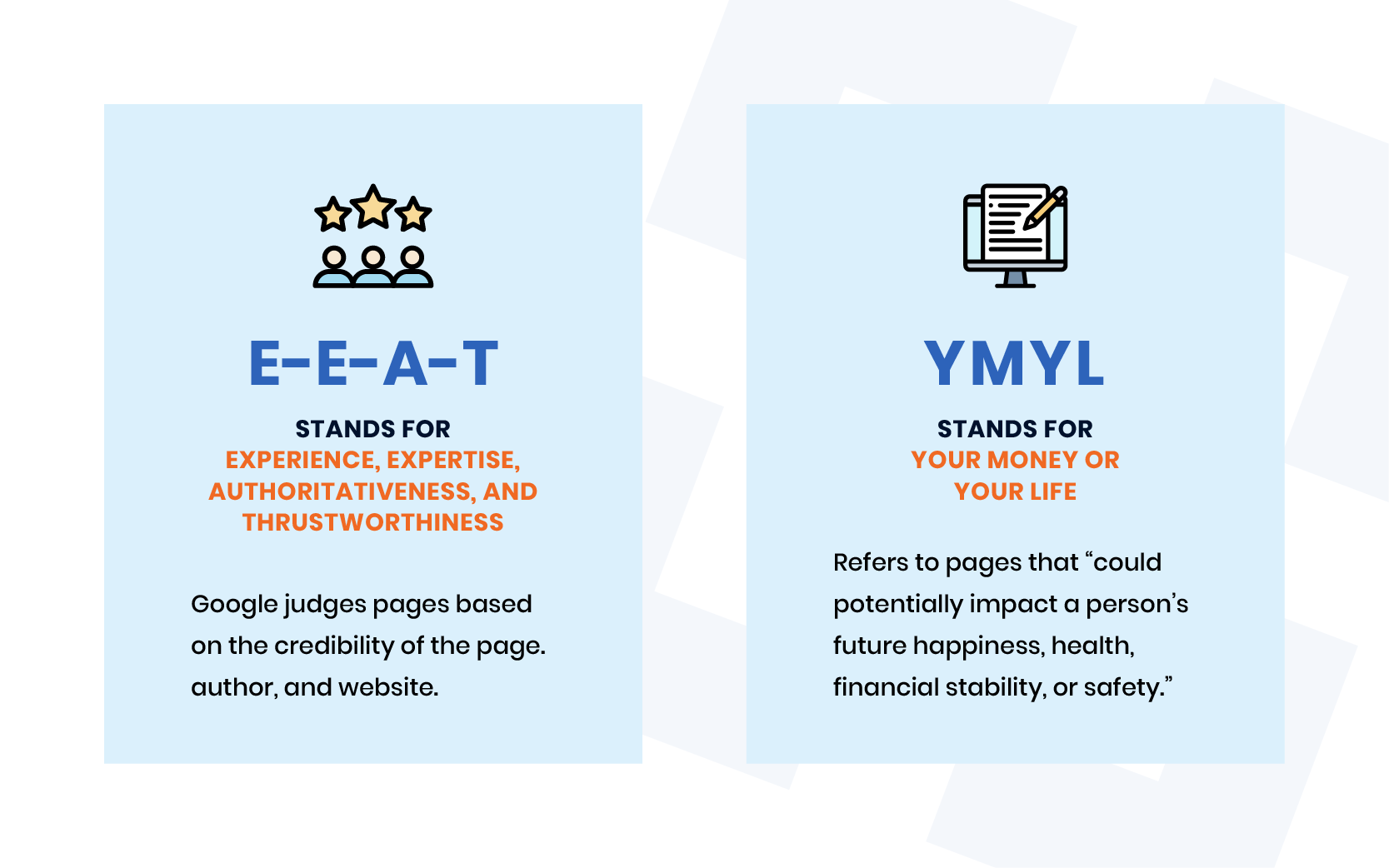
When someone needs legal help, they don’t check the Yellow Pages or wait for a referral. They open Google.
Most searches begin on mobile, and legal queries are no exception. If your firm doesn’t appear in those results, you’re invisible to the people who need you most.
The potential for growth through search is unmatched. Google processes more than 14 billion searches every day. Even small gains in visibility can lead to a steady flow of qualified leads. The firms at the top get the clicks, the calls, and the cases. SEO creates leverage that builds over time.
When we look at our clients’ websites, we see that, on average, 80%+ of all traffic comes from organic searches.
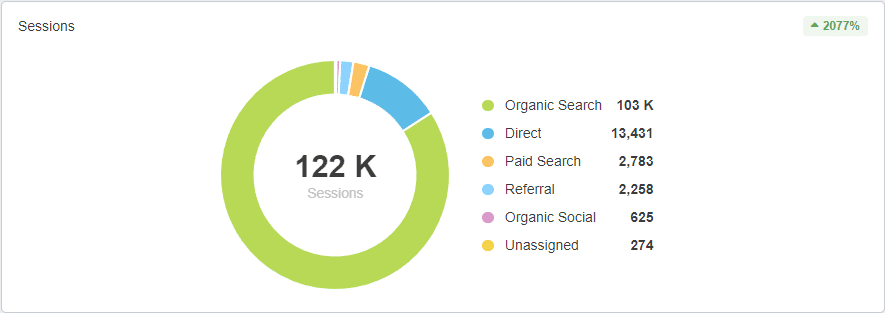
Most marketing channels stop working the moment you stop paying. SEO works differently.
The content you publish today can continue to drive traffic and leads months, or even years, from now. That kind of compounding growth makes SEO one of the most efficient and scalable ways to market a law firm.
As your site earns trust, ranks for more queries, and gains authority, your visibility increases without a proportional rise in cost. The result is steady, qualified traffic that does not depend on constant spending or pay-to-play channels.
Ranking in the top organic slot used to guarantee traffic. Backlinko found the #1 result gets 27.6% of clicks. But AI-generated answers are changing the game.
According to Ahrefs, when a Google AI Overview appears, CTR for top listings drops by an average of 34.5%, with even steeper declines for non-branded legal searches
Google tracks hundreds of signals, but only a handful matter for law firms.
Relevance, authority, and user experience carry the most weight, especially in high-trust, high-stakes industries like legal services.
You don’t need to chase every algorithm update. You need to get the fundamentals right.
Firms that focus on what actually influences rankings consistently outperform those wasting time on tactics that no longer work.
Google tracks hundreds of signals to decide which pages deserve to rank. But for law firms, five core factors influence visibility more than anything else: relevance, quality, user experience, authority, and locality.
When you get these right, everything else becomes easier. You build trust, keep users engaged, and show search engines that your site deserves a top spot.
Thin, generic content doesn’t cut it, especially in legal SEO. Your pages need to address specific legal concerns in a way that’s accurate, complete, and actionable.
Links from reputable sources, legal directories, press mentions, or local organizations, show Google that your content is credible and valuable.
Fast load times, proper schema markup, mobile-friendly design, and clean code all make your site easier to crawl and index.
Mobile-first design, logical navigation, readable text, and strong page performance help users find what they need and stick around longer.
Google wants to know who you are, where you’re located, and what services you provide. Clear NAP info, local schema, and consistent directory listings help build that connection.
Key takeaway: You don’t need to chase every algorithm update. Just focus on the five signals that move the needle for legal visibility.
AI-powered summaries are reshaping how people access legal information.
Users no longer scroll through links. Instead, they rely on direct answers from tools like ChatGPT, Bing Copilot, and Google’s AI Overviews.
These platforms favor content that is clearly structured, authoritative, and easy to extract.
Here’s what law firms need to focus on to appear in AI-driven results:
These priorities align with how modern AI tools evaluate and select content. Perplexity AI, for example, emphasizes that content structure and citations are key factors in how it chooses sources.
Key takeaway: AI-driven search favors content that is structured, credible, and rich. To stay visible, your pages must be reference-worthy—not just rank-worthy.

“My website continues to dominate all the top website searches in my industry and my business has grown 10-fold as a result.”
Oykhman Criminal Defence
Ranking is only the first step. If your content doesn’t engage readers or build trust, it won’t generate leads no matter how high you show up in search.
Most law firm websites fall short because their content is either too thin, too broad, or clearly written for Google instead of real people.
Creating content that converts means understanding what your audience actually wants, then answering it with clarity, authority, and structure. When done right, great content builds visibility, earns links, and turns searchers into clients.
If your content doesn’t match what people are actually searching for, it won’t rank or convert. Search intent tells you why someone types a query into Google. Your job is to meet that intent, clearly and directly.
Search intent, the purpose behind what users type, is one of the most important SEO factors today because it ensures your content meets actual user needs.
Key takeaway: Intent is the ‘why’ behind every query. If your content doesn’t meet that need, it won’t earn the click or the client.
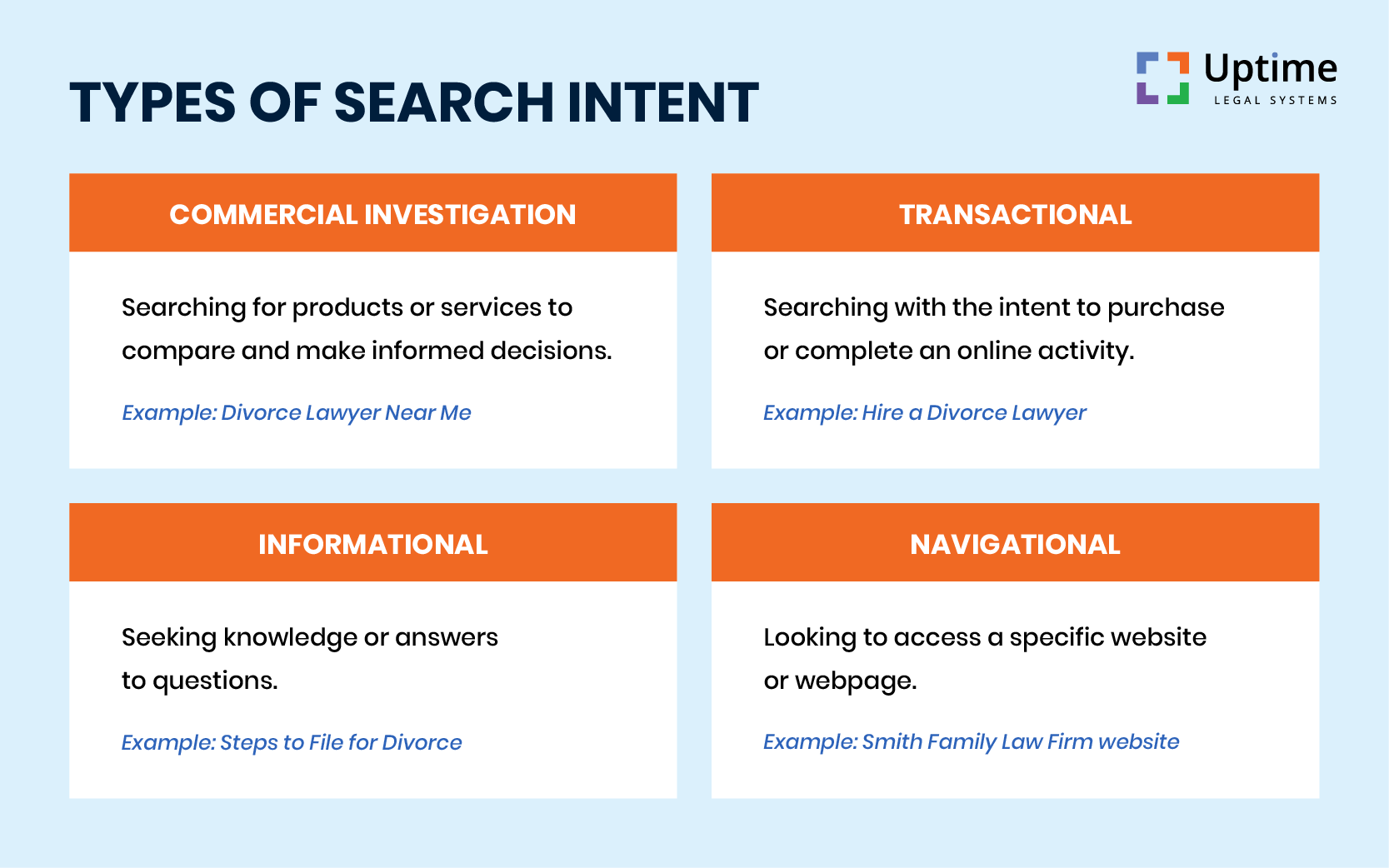
Not all content serves the same purpose. Practice area pages are built to convert. Blog content is built to attract. You need both, but you need to know when and why to use each.
Both types work together. Blogs attract traffic. Practice pages convert it. Smart SEO makes sure they’re linked, aligned, and easy to navigate.
Here’s an example of a hyper-specific practice area page.
Most law firms target the wrong keywords. They chase broad, high-volume terms like “lawyer” or “criminal defense,” which are too competitive, too generic, and disconnected from how real clients search.
Instead, your goal is to rank for specific, intent-driven phrases that match what your ideal clients are looking for at the exact moment they need help.
A strong keyword doesn’t just pull in traffic. It attracts the right traffic. The kind of people who need your services and are ready to act.
Good keywords strike a balance between visibility and achievability. They’re specific, actionable, and tied to real client intent.
Adding location and intent to your keywords turns generic terms into qualified traffic. You don’t need to rank for “divorce lawyer.” You need to rank for “divorce lawyer in Atlanta” or “affordable divorce attorney for fathers.”
These modifiers tell search engines exactly who you serve and what you offer.
Focus on:
These modifiers help your firm show up in more focused, less competitive searches where people are more likely to convert.
Most law firm websites do not need more content. They need better structure.
On-page SEO focuses on making your existing content clearer, faster, and easier for search engines to understand. This involves fixing what slows your pages down, confuses your readers, or prevents Google from recognizing your authority.
Small changes in structure can lead to big gains in visibility. When your titles, headers, and internal links are properly optimized, your content becomes easier to crawl and more aligned with what people are actually searching for.
This is the technical side of content. It’s also where many firms fall behind.
Search engines need structure to understand your content and so do your readers. Headers (H1, H2, H3) help organize your page, highlight what matters, and guide both crawlers and humans through your content.
Here’s how to structure it properly:
A clean header structure makes your content easier to scan, easier to rank, and more likely to be pulled into AI summaries or featured snippets.
Internal links tell Google which pages matter and how your content is connected. Done right, they help search engines understand your site’s structure and help visitors navigate it more easily.
Here’s how to build internal links that support SEO:
This structure helps Google see your site as a trusted resource, not just a collection of isolated posts.
Here’s an example.
Schema markup helps search engines understand your content in a more detailed, structured way. It adds context to your pages, improves how you appear in search results, and can boost your chances of showing up in featured snippets or AI Overviews.
Focus on a few key types for quick gains:
You don’t need to mark up everything. Prioritize elements that reinforce your expertise, local presence, and search visibility. Tools like the Schema Markup Generator by Merkle make it easy to create clean, valid JSON-LD code.
You can have great content and perfect on-page SEO. But without links from other websites, your site will struggle to rank.
Backlinks remain one of Google’s strongest trust signals. They indicate that other sites see your content as credible and valuable.
For law firms, effective link building means earning authority from sources that matter. Focus on legal directories, press features, local organizations, and niche publications. These links not only improve rankings but also build lasting visibility and reputation across the web.
Not all legal directories are worth your time. Some exist purely to sell backlinks. Others still carry real authority and can drive qualified traffic.
Focus on these:
Avoid low-quality directories with little editorial oversight or traffic. If a site feels spammy or makes unrealistic promises, skip it.
Sometimes your firm gets mentioned online, but without a link. These unlinked brand mentions are valuable and often easy to turn into backlinks.
Here’s how to leverage them:
These links are some of the easiest to earn because the relationship and context already exist.
If someone searches “divorce lawyer near me,” you’re not competing in traditional organic rankings. You’re competing in the map.
Google’s Local Pack takes up prime space at the top of the results page. It drives a large share of calls and clicks for law firms.
To appear there, you need a properly optimized Google Business Profile, consistent local citations, and strong signals of local relevance. Local SEO shows Google that you’re not just a trusted expert. It proves that you’re the right expert for that location.
The Local Pack is the set of three business listings that shows up in a map section at the top of search results. When people search for a local service, that pack often appears before any organic listings, especially on mobile and voice devices.
That placement means being part of the Local Pack can make or break your visibility.
Google chooses who appears based on three factors: proximity, relevance, and prominence (which includes reviews, citations, and web mentions).
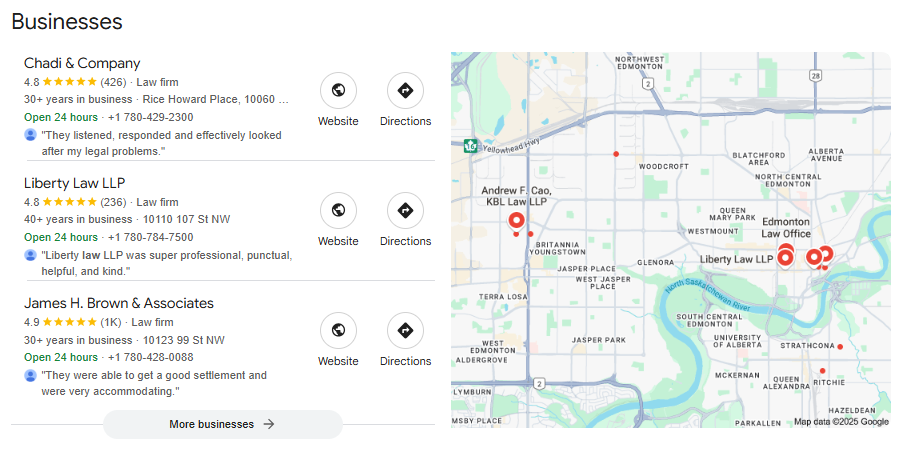
Your Google Business Profile is your law firm’s storefront in local search. If it’s incomplete, outdated, or inconsistent, you’ll lose visibility.
A fully optimized profile makes it easier for clients to find you, contact you, and trust you.
Here’s what to focus on:
Treat your GBP like a landing page. It often creates the first impression before anyone visits your site.
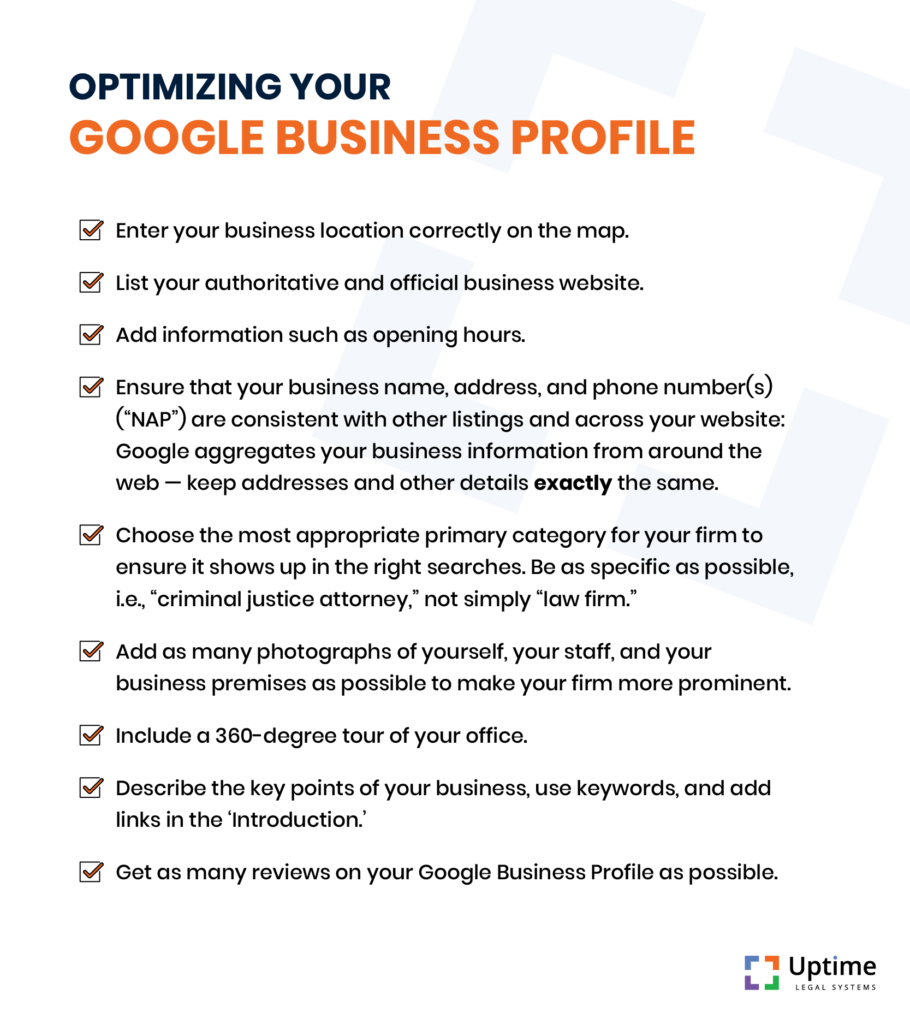
These elements may seem secondary, but they heavily influence whether your firm shows up and whether someone clicks on your listing.
Here’s how to get them right:
These elements all feed into Google’s local algorithm. They help you build trust, improve engagement, and increase your visibility across the map and mobile results.
You can have the best content in your market, but if your site is slow, clunky, or hard to crawl, Google won’t rank it. Technical SEO ensures that your site is accessible, fast, and easy for search engines to understand. It’s the foundation everything else is built on.
Most law firms overlook this part completely. That’s a mistake. Fixing technical issues can boost your rankings without writing a single new word.
Google now ranks your site based on its mobile version, not the desktop one. If your site isn’t fast, responsive, and easy to use on a phone, you’re already falling behind. That’s where Core Web Vitals come in.
These three metrics show how user-friendly your mobile experience really is:
Use PageSpeed Insights or the Core Web Vitals report in Search Console to see how your site performs. Fixing image sizes, JavaScript issues, or layout shifts can have a direct impact on rankings.
If Google can’t easily find and understand your content, it won’t rank it. That’s why your site’s structure matters. A clean, well-organized layout helps both users and search engines navigate your pages.
Every important page, like practice areas, blog posts, or resource guides, should be accessible within three clicks from your homepage. Avoid burying valuable content deep in your site where it gets overlooked.
Keep your architecture flat and logical. Group related pages under clear sections, and use internal links to connect them. This improves crawl efficiency and helps Google understand which pages carry the most weight.
Use tools like Screaming Frog or the Coverage report in Google Search Console to identify crawl issues, broken links, or orphaned pages. Fixing these errors makes your site easier to index and more authoritative in the eyes of search engines.
If you’re only tracking keyword rankings, you’re not measuring real SEO performance. Rankings can fluctuate daily and don’t always reflect meaningful progress. What actually matters is whether your SEO is driving qualified leads, calls, and revenue.
You need to track the metrics that tie directly to your business goals. That means looking beyond surface-level data and focusing on what turns visibility into clients.
When you measure what matters, you can make better decisions, spot real opportunities, and prove that your SEO is worth the investment.
You’ve probably seen those bloated SEO reports packed with keyword charts and vague traffic graphs. They look impressive until you realize they have nothing to do with new cases or actual revenue.
That’s the problem with tracking the wrong metrics.
Here’s what actually matters:
Rankings rise and fall. What matters is whether your site generates business. If your metrics don’t show that, you’re measuring the wrong things.
Most law firms either rely on a basic Google Analytics report or get flooded with flashy dashboards that don’t mean much.
The reality is this: some SEO tools are free and limited, others are expensive but essential. Some are AI-enabled and packed with features, while others do one thing well and nothing more. Knowing which ones to trust and what to look for is half the battle.
Here’s what we recommend:
You don’t need every tool, but you do need the right stack to track what’s really working. Without that, you’re flying blind.
SEO isn’t fast. It’s not like flipping a switch or launching a paid campaign. It’s more like planting seeds. If you invest consistently and take care of it properly, the return grows over time. That’s why setting the right expectations from the start is critical.
Most firms begin to see meaningful progress within three to six months. In more competitive markets, it can take longer. But once you start ranking, you’re not paying for every click or fighting for daily visibility. You’re earning traffic that continues to come in without added cost.
SEO also delivers one of the highest long-term returns in legal marketing. Content you publish today can still bring in clients a year from now without spending another dollar on ads.
If you need instant results, SEO isn’t the right channel. But if you want a steady, sustainable pipeline that works long after the work is done, it’s one of the smartest investments you can make.
SEO success for law firms doesn’t come from tricks or shortcuts. It comes from consistent, strategic work that positions you as the best answer for the people searching in your market.
When your site reflects your expertise, and your strategy aligns with real client needs, everything starts to click.
Start by asking the right questions:
From here, use the chapter links to go deeper into each part of your strategy. Whether you implement in-house or delegate it out, you now have the knowledge to lead with clarity.
You don’t need to be an SEO expert. But you do need to stay in control, and that starts with understanding how the pieces work together to grow your firm.
Ready to maximize your marketing budget? Fill out the contact form or call us today for a complimentary consultation. We will listen to your story, work to define your business objectives, and recommend an approach to deliver maximum ROI for your firm.
By using this website, you consent to our use of cookies in accordance with our Cookie Policy. Cookies help us enhance your browsing experience and provide personalized content. If you do not agree to our use of cookies, please adjust your browser settings accordingly.